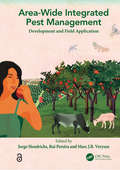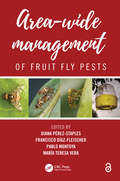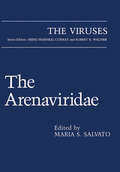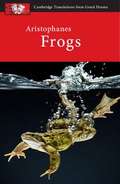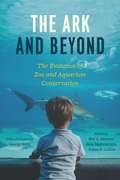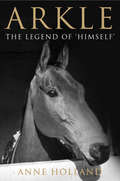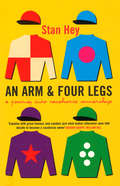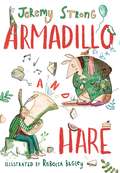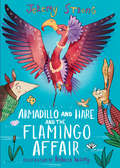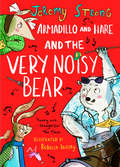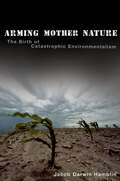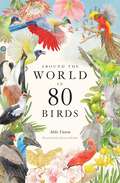- Table View
- List View
Area-wide Integrated Pest Management: Development and Field Application
by Jorge Hendrichs Rui Pereira Marc J. B. VreysenOver 98% of sprayed insecticides and 95% of herbicides reach a destination other than their target species, including non-target species, air, water and soil. The extensive reliance on insecticide use reduces biodiversity, contributes to pollinator decline, destroys habitat, and threatens endangered species. This book offers a more effective application of the Integrated Pest Management (IPM) approach, on an area-wide (AW) or population-wide (AW-IPM) basis, which aims at the management of the total population of a pest, involving a coordinated effort over often larger areas. For major livestock pests, vectors of human diseases and pests of high-value crops with low pest tolerance, there are compelling economic reasons for participating in AW-IPM. This new textbook attempts to address various fundamental components of AW-IPM, e.g. the importance of relevant problem-solving research, the need for planning and essential baseline data collection, the significance of integrating adequate tools for appropriate control strategies, and the value of pilot trials, etc. With chapters authored by 184 experts from more than 31 countries, the book includes many technical advances in the areas of genetics, molecular biology, microbiology, resistance management, and social sciences that facilitate the planning and implementing of area-wide strategies. The book is essential reading for the academic and applied research community as well as national and regional government plant and human/animal health authorities with responsibility for protecting plant and human/animal health.
Area-wide Integrated Pest Management: Development and Field Application
by Jorge Hendrichs; Rui Pereira; Marc J.B. VreysenOver 98% of sprayed insecticides and 95% of herbicides reach a destination other than their target species, including non-target species, air, water and soil. The extensive reliance on insecticide use reduces biodiversity, contributes to pollinator decline, destroys habitat, and threatens endangered species. This book offers a more effective application of the Integrated Pest Management (IPM) approach, on an area-wide (AW) or population-wide (AW-IPM) basis, which aims at the management of the total population of a pest, involving a coordinated effort over often larger areas. For major livestock pests, vectors of human diseases and pests of high-value crops with low pest tolerance, there are compelling economic reasons for participating in AW-IPM. This new textbook attempts to address various fundamental components of AW-IPM, e.g. the importance of relevant problem-solving research, the need for planning and essential baseline data collection, the significance of integrating adequate tools for appropriate control strategies, and the value of pilot trials, etc. With chapters authored by 184 experts from more than 31 countries, the book includes many technical advances in the areas of genetics, molecular biology, microbiology, resistance management, and social sciences that facilitate the planning and implementing of area-wide strategies. The book is essential reading for the academic and applied research community as well as national and regional government plant and human/animal health authorities with responsibility for protecting plant and human/animal health.
Area-Wide Management of Fruit Fly Pests
by Pablo Montoya Diana Perez-Staples Francisco Diaz-Fleischer Maria Teresa VeraFruit fly (Diptera: Tephritidae) pests have a profound impact on horticultural production and economy of many countries. It is fundamental to understand their biology and evaluate methods for their suppression, containment, or eradication. Area-Wide Management of Fruit Fly Pests comprises contributions from scientists from around the world on several species of tephritids working on diverse subjects with a focus on area-wide management of these pests. The first three sections of the book explore aspects of the biology, ecology, physiology, behavior, taxonomy, and morphology of fruit flies. The next two sections provide evidence on the efficacy of attractants, risk assessment, quarantine, and post-harvest control methods. The fifth and sixth sections examine biological control methods such as the Sterile Insect Technique and the use of natural enemies of fruit flies. The seventh section focuses on area-wide integrated pest management and action programs. Finally, the eighth section examines social, economic, and policy issues of action programs aimed at involving the wider community in the control of these pests and facilitate the development of control programs. Features: Presents information on the biology of tephritid flies. Provides knowledge on the use of natural enemies of fruit flies for their biological control. Includes research results on models and diets used for the Sterile Insect Technique. Reports developments on the chemical ecology of fruit flies that contribute to make control methods more specific and efficient. Reviews subjects such as Holistic Pest Management and Area-Wide Management Programs including social, economic, and policy issues in various countries. The Open Access version of this book, available at https://www.taylorfrancis.com/books/9780429355738, has been made available under a Creative Commons Attribution-Non Commercial-No Derivatives 4.0 license.
Area-Wide Management of Fruit Fly Pests
by Pablo Montoya Diana Perez-Staples Francisco Diaz-Fleischer Maria Teresa VeraFruit fly (Diptera: Tephritidae) pests have a profound impact on horticultural production and economy of many countries. It is fundamental to understand their biology and evaluate methods for their suppression, containment, or eradication. Area-Wide Management of Fruit Fly Pests comprises contributions from scientists from around the world on several species of tephritids working on diverse subjects with a focus on area-wide management of these pests. The first three sections of the book explore aspects of the biology, ecology, physiology, behavior, taxonomy, and morphology of fruit flies. The next two sections provide evidence on the efficacy of attractants, risk assessment, quarantine, and post-harvest control methods. The fifth and sixth sections examine biological control methods such as the Sterile Insect Technique and the use of natural enemies of fruit flies. The seventh section focuses on area-wide integrated pest management and action programs. Finally, the eighth section examines social, economic, and policy issues of action programs aimed at involving the wider community in the control of these pests and facilitate the development of control programs. Features: Presents information on the biology of tephritid flies. Provides knowledge on the use of natural enemies of fruit flies for their biological control. Includes research results on models and diets used for the Sterile Insect Technique. Reports developments on the chemical ecology of fruit flies that contribute to make control methods more specific and efficient. Reviews subjects such as Holistic Pest Management and Area-Wide Management Programs including social, economic, and policy issues in various countries. The Open Access version of this book, available at https://www.taylorfrancis.com/books/9780429355738, has been made available under a Creative Commons Attribution-Non Commercial-No Derivatives 4.0 license.
The Arenaviridae (The Viruses)
by Maria S. SalvatoIn this volume, a distinguished international group of contributors present the latest molecular, organismal, and epidemiological research on arenaviruses. Their work will broaden both the clinician's and the researcher's knowledge of basic mechanisms of immunological tolerance, viral immunosuppression, the nature of protective immune responses to vaccination, and viral effects on cell functions.
Aristophanes: Frogs (Cambridge Translations From Greek Drama (PDF)Ser.)
by Judith Affleck Clive Letchford John HarrisonTreating ancient plays as living drama. Classical Greek drama is brought vividly to life in this series of new translations. Students are encouraged to engage with the text through detailed commentaries, including suggestions for discussion and analysis. Numerous practical questions stimulate ideas on staging and encourage students to explore the play's dramatic qualities. Frogs is suitable for students of Classical Civilisation and Drama. Features include a full synopsis of the play, commentary alongside translation for easy reference and a comprehensive introduction to the Greek Theatre. Frogs is aimed at A-level and undergraduate students in the UK, and college students in North America.
The Ark and Beyond: The Evolution of Zoo and Aquarium Conservation (Convening Science: Discovery at the Marine Biological Laboratory)
by Ben A. Minteer Jane Maienschein James P. CollinsScores of wild species and ecosystems around the world face a variety of human-caused threats, from habitat destruction and fragmentation to rapid climate change. But there is hope, and it, too, comes in a most human form: zoos and aquariums. Gathering a diverse, multi-institutional collection of leading zoo and aquarium scientists as well as historians, philosophers, biologists, and social scientists, The Ark and Beyond traces the history and underscores the present role of these organizations as essential conservation actors. It also offers a framework for their future course, reaffirming that if zoos and aquariums make biodiversity conservation a top priority, these institutions can play a vital role in tackling conservation challenges of global magnitude. While early menageries were anything but the centers of conservation that many zoos are today, a concern with wildlife preservation has been an integral component of the modern, professionally run zoo since the nineteenth century. From captive breeding initiatives to rewilding programs, zoos and aquariums have long been at the cutting edge of research and conservation science, sites of impressive new genetic and reproductive techniques. Today, their efforts reach even further beyond recreation, with educational programs, community-based conservation initiatives, and international, collaborative programs designed to combat species extinction and protect habitats at a range of scales. Addressing related topics as diverse as zoo animal welfare, species reintroductions, amphibian extinctions, and whether zoos can truly be “wild,” this book explores the whole range of research and conservation practices that spring from zoos and aquariums while emphasizing the historical, scientific, and ethical traditions that shape these efforts. Also featuring an inspiring foreword by the late George Rabb, president emeritus of the Chicago Zoological Society / Brookfield Zoo, The Ark and Beyond illuminates these institutions’ growing significance to the preservation of global biodiversity in this century.
The Ark and Beyond: The Evolution of Zoo and Aquarium Conservation (Convening Science: Discovery at the Marine Biological Laboratory)
by Ben A. Minteer Jane Maienschein James P. CollinsScores of wild species and ecosystems around the world face a variety of human-caused threats, from habitat destruction and fragmentation to rapid climate change. But there is hope, and it, too, comes in a most human form: zoos and aquariums. Gathering a diverse, multi-institutional collection of leading zoo and aquarium scientists as well as historians, philosophers, biologists, and social scientists, The Ark and Beyond traces the history and underscores the present role of these organizations as essential conservation actors. It also offers a framework for their future course, reaffirming that if zoos and aquariums make biodiversity conservation a top priority, these institutions can play a vital role in tackling conservation challenges of global magnitude. While early menageries were anything but the centers of conservation that many zoos are today, a concern with wildlife preservation has been an integral component of the modern, professionally run zoo since the nineteenth century. From captive breeding initiatives to rewilding programs, zoos and aquariums have long been at the cutting edge of research and conservation science, sites of impressive new genetic and reproductive techniques. Today, their efforts reach even further beyond recreation, with educational programs, community-based conservation initiatives, and international, collaborative programs designed to combat species extinction and protect habitats at a range of scales. Addressing related topics as diverse as zoo animal welfare, species reintroductions, amphibian extinctions, and whether zoos can truly be “wild,” this book explores the whole range of research and conservation practices that spring from zoos and aquariums while emphasizing the historical, scientific, and ethical traditions that shape these efforts. Also featuring an inspiring foreword by the late George Rabb, president emeritus of the Chicago Zoological Society / Brookfield Zoo, The Ark and Beyond illuminates these institutions’ growing significance to the preservation of global biodiversity in this century.
The Ark and Beyond: The Evolution of Zoo and Aquarium Conservation (Convening Science: Discovery at the Marine Biological Laboratory)
by Ben A. Minteer Jane Maienschein James P. CollinsScores of wild species and ecosystems around the world face a variety of human-caused threats, from habitat destruction and fragmentation to rapid climate change. But there is hope, and it, too, comes in a most human form: zoos and aquariums. Gathering a diverse, multi-institutional collection of leading zoo and aquarium scientists as well as historians, philosophers, biologists, and social scientists, The Ark and Beyond traces the history and underscores the present role of these organizations as essential conservation actors. It also offers a framework for their future course, reaffirming that if zoos and aquariums make biodiversity conservation a top priority, these institutions can play a vital role in tackling conservation challenges of global magnitude. While early menageries were anything but the centers of conservation that many zoos are today, a concern with wildlife preservation has been an integral component of the modern, professionally run zoo since the nineteenth century. From captive breeding initiatives to rewilding programs, zoos and aquariums have long been at the cutting edge of research and conservation science, sites of impressive new genetic and reproductive techniques. Today, their efforts reach even further beyond recreation, with educational programs, community-based conservation initiatives, and international, collaborative programs designed to combat species extinction and protect habitats at a range of scales. Addressing related topics as diverse as zoo animal welfare, species reintroductions, amphibian extinctions, and whether zoos can truly be “wild,” this book explores the whole range of research and conservation practices that spring from zoos and aquariums while emphasizing the historical, scientific, and ethical traditions that shape these efforts. Also featuring an inspiring foreword by the late George Rabb, president emeritus of the Chicago Zoological Society / Brookfield Zoo, The Ark and Beyond illuminates these institutions’ growing significance to the preservation of global biodiversity in this century.
The Ark and Beyond: The Evolution of Zoo and Aquarium Conservation (Convening Science: Discovery at the Marine Biological Laboratory)
by Ben A. Minteer Jane Maienschein James P. CollinsScores of wild species and ecosystems around the world face a variety of human-caused threats, from habitat destruction and fragmentation to rapid climate change. But there is hope, and it, too, comes in a most human form: zoos and aquariums. Gathering a diverse, multi-institutional collection of leading zoo and aquarium scientists as well as historians, philosophers, biologists, and social scientists, The Ark and Beyond traces the history and underscores the present role of these organizations as essential conservation actors. It also offers a framework for their future course, reaffirming that if zoos and aquariums make biodiversity conservation a top priority, these institutions can play a vital role in tackling conservation challenges of global magnitude. While early menageries were anything but the centers of conservation that many zoos are today, a concern with wildlife preservation has been an integral component of the modern, professionally run zoo since the nineteenth century. From captive breeding initiatives to rewilding programs, zoos and aquariums have long been at the cutting edge of research and conservation science, sites of impressive new genetic and reproductive techniques. Today, their efforts reach even further beyond recreation, with educational programs, community-based conservation initiatives, and international, collaborative programs designed to combat species extinction and protect habitats at a range of scales. Addressing related topics as diverse as zoo animal welfare, species reintroductions, amphibian extinctions, and whether zoos can truly be “wild,” this book explores the whole range of research and conservation practices that spring from zoos and aquariums while emphasizing the historical, scientific, and ethical traditions that shape these efforts. Also featuring an inspiring foreword by the late George Rabb, president emeritus of the Chicago Zoological Society / Brookfield Zoo, The Ark and Beyond illuminates these institutions’ growing significance to the preservation of global biodiversity in this century.
The Ark and Beyond: The Evolution of Zoo and Aquarium Conservation (Convening Science: Discovery at the Marine Biological Laboratory)
by Ben A. Minteer Jane Maienschein James P. CollinsScores of wild species and ecosystems around the world face a variety of human-caused threats, from habitat destruction and fragmentation to rapid climate change. But there is hope, and it, too, comes in a most human form: zoos and aquariums. Gathering a diverse, multi-institutional collection of leading zoo and aquarium scientists as well as historians, philosophers, biologists, and social scientists, The Ark and Beyond traces the history and underscores the present role of these organizations as essential conservation actors. It also offers a framework for their future course, reaffirming that if zoos and aquariums make biodiversity conservation a top priority, these institutions can play a vital role in tackling conservation challenges of global magnitude. While early menageries were anything but the centers of conservation that many zoos are today, a concern with wildlife preservation has been an integral component of the modern, professionally run zoo since the nineteenth century. From captive breeding initiatives to rewilding programs, zoos and aquariums have long been at the cutting edge of research and conservation science, sites of impressive new genetic and reproductive techniques. Today, their efforts reach even further beyond recreation, with educational programs, community-based conservation initiatives, and international, collaborative programs designed to combat species extinction and protect habitats at a range of scales. Addressing related topics as diverse as zoo animal welfare, species reintroductions, amphibian extinctions, and whether zoos can truly be “wild,” this book explores the whole range of research and conservation practices that spring from zoos and aquariums while emphasizing the historical, scientific, and ethical traditions that shape these efforts. Also featuring an inspiring foreword by the late George Rabb, president emeritus of the Chicago Zoological Society / Brookfield Zoo, The Ark and Beyond illuminates these institutions’ growing significance to the preservation of global biodiversity in this century.
The Ark and Beyond: The Evolution of Zoo and Aquarium Conservation (Convening Science: Discovery at the Marine Biological Laboratory)
Scores of wild species and ecosystems around the world face a variety of human-caused threats, from habitat destruction and fragmentation to rapid climate change. But there is hope, and it, too, comes in a most human form: zoos and aquariums. Gathering a diverse, multi-institutional collection of leading zoo and aquarium scientists as well as historians, philosophers, biologists, and social scientists, The Ark and Beyond traces the history and underscores the present role of these organizations as essential conservation actors. It also offers a framework for their future course, reaffirming that if zoos and aquariums make biodiversity conservation a top priority, these institutions can play a vital role in tackling conservation challenges of global magnitude. While early menageries were anything but the centers of conservation that many zoos are today, a concern with wildlife preservation has been an integral component of the modern, professionally run zoo since the nineteenth century. From captive breeding initiatives to rewilding programs, zoos and aquariums have long been at the cutting edge of research and conservation science, sites of impressive new genetic and reproductive techniques. Today, their efforts reach even further beyond recreation, with educational programs, community-based conservation initiatives, and international, collaborative programs designed to combat species extinction and protect habitats at a range of scales. Addressing related topics as diverse as zoo animal welfare, species reintroductions, amphibian extinctions, and whether zoos can truly be “wild,” this book explores the whole range of research and conservation practices that spring from zoos and aquariums while emphasizing the historical, scientific, and ethical traditions that shape these efforts. Also featuring an inspiring foreword by the late George Rabb, president emeritus of the Chicago Zoological Society / Brookfield Zoo, The Ark and Beyond illuminates these institutions’ growing significance to the preservation of global biodiversity in this century.
Arkle: The Legend of 'Himself'
by Anne HollandIn 1964, Arkle's first-place finish in the Cheltenham Gold Cup was the first big win by Ireland's most celebrated racehorse: the horse by which all others are measured. Fifty years on from the start of his incredible career - which included wins in the Cheltenham Gold Cup (three times), Irish Grand National, Hennessy Gold Cup, King George VI Chase and Punchestown Gold Cup - Anne Holland looks at Arkle's life and legend through the eyes of those who knew him best. She describes Arkle's career, his incredible wins, and the people involved with him, interviewing many of his connections, including Jim Dreaper, Paddy Woods, Tom Taaffe, sculptor Emma McDermott, the Baker family and others. Arkle was a star - the story goes that he received items of fan mail addressed to 'Himself, Ireland' - and this is a well-researched and intimate portrait of a legendary horse. Shortlisted for Horse Racing Book of the Year 2014, British Sports Book Awards
Arlo The Lion Who Couldn't Sleep
by Catherine RaynerArlo The Lion Who Couldn't Sleep is a beautifully illustrated story with a gentle mindfulness message from award-wining author-illustrator Catherine Rayner. Shortlisted for the Kate Greenaway Medal, it's an ideal bedtime book, and especially helpful for little ones who have trouble going to sleep.Arlo the lion is exhausted. He just can't drop off, no matter what he tries. It's either too hot, or too cold; too loud or too quiet. But then he meets Owl. She can sleep through the day, which isn't easy when most other animals are awake! Will Arlo ever get any rest? Perhaps his new friend has some special tricks she can teach him.
An Arm And Four Legs: A Journey into Racehorse Ownership
by Stan HeyEver wondered what it might be like to own a horse, not just back it with a pony on the nose - own it? Stan Hey did. A veteran of the windswept racecourses of National Hunt he finally decided to stop betting on other people's horses and join the inner circle. With the growth of partnerships and syndicates this has become increasingly possible so four horses, two trainers, and a few thousand pounds later Stan Hey had this story to tell. An Arm and Four Legs is his honest account of the pitfalls of racehorse ownership. Its fierce disappointments, escalating costs, skulduggery and deceit are set alongside the intense pleasure offered by an afternoon spent at the track, drinking, betting and chatting to your trainer while the rest of the world has its feet tucked under a desk.
Armadillo and Hare (Small Tales from the Big Forest #1)
by Jeremy StrongARMADILLO AND HARE live with their friends in the Big Forest. Hare loves dancing. Armadillo loves cheese sandwiches. Hare loves playing the tuba. Armadillo loves cheese sandwiches. Hare loves his best friend, Armadillo. Armadillo loves Hare - AND cheese sandwiches!
Armadillo and Hare and the Flamingo Affair (Small Tales from the Big Forest #3)
by Jeremy StrongArmadillo and Hare are an unlikely pair. Armadillo is often a little grumpy, while Hare is a more cheerful sort.But, despite their differences, they are very best friends.One day, something incredible happens. Someone rather fabulous is singing and dancing in the Big Forest. Who could it be?It's Flamingo!Has this flamboyant new friend found a forever home in the Big Forest?Fun, friendship and flamingo fabulousness abound in these delightful, charming tales.
Armadillo and Hare and the Very Noisy Bear (Small Tales from the Big Forest #2)
by Jeremy StrongArmadillo and Hare are the best of friends. They live together in a little house in the Big Forest.It's normally very quiet in the Big Forest.Armadillo likes it when it's quiet. Hare likes music and excitement.Today there's a lot of bashing and crashing going on! Someone is playing the drums. Very loudly.It's a very noisy bear! What will our friends make of the new arrival?Return to the Big Forest for even more fun, friendship - and cheese!
The Armies of Daylight: The Time Of The Dark, The Walls Of Air, And The Armies Of Daylight (Darwath Trilogy #3)
by Barbara HamblyA whirlwind fantasy classic set in the richest world imaginable, with unforgettable characters and the highest stakes – The Armies of Daylight is the third and final book in Barbara Hambly’s epic Darwath Trilogy.
Arming Mother Nature: The Birth of Catastrophic Environmentalism
by Jacob Darwin HamblinWhen most Americans think of environmentalism, they think of the political left, of vegans dressed in organic-hemp fabric, lofting protest signs. In reality, writes Jacob Darwin Hamblin, the movement--and its dire predictions--owe more to the Pentagon than the counterculture. In Arming Mother Nature, Hamblin argues that military planning for World War III essentially created "catastrophic environmentalism": the idea that human activity might cause global natural disasters. This awareness, Hamblin shows, emerged out of dark ambitions, as governments poured funds into environmental science after World War II, searching for ways to harness natural processes--to kill millions of people. Proposals included the use of nuclear weapons to create artificial tsunamis or melt the ice caps to drown coastal cities; setting fire to vast expanses of vegetation; and changing local climates. Oxford botanists advised British generals on how to destroy enemy crops during the war in Malaya; American scientists attempted to alter the weather in Vietnam. This work raised questions that went beyond the goal of weaponizing nature. By the 1980s, the C.I.A. was studying the likely effects of global warming on Soviet harvests. "Perhaps one of the surprises of this book is not how little was known about environmental change, but rather how much," Hamblin writes. Driven initially by strategic imperatives, Cold War scientists learned to think globally and to grasp humanity's power to alter the environment. "We know how we can modify the ionosphere," nuclear physicist Edward Teller proudly stated. "We have already done it." Teller never repented. But many of the same individuals and institutions that helped the Pentagon later warned of global warming and other potential disasters. Brilliantly argued and deeply researched, Arming Mother Nature changes our understanding of the history of the Cold War and the birth of modern environmental science.
Arming Mother Nature: The Birth of Catastrophic Environmentalism
by Jacob Darwin HamblinWhen most Americans think of environmentalism, they think of the political left, of vegans dressed in organic-hemp fabric, lofting protest signs. In reality, writes Jacob Darwin Hamblin, the movement--and its dire predictions--owe more to the Pentagon than the counterculture. In Arming Mother Nature, Hamblin argues that military planning for World War III essentially created "catastrophic environmentalism": the idea that human activity might cause global natural disasters. This awareness, Hamblin shows, emerged out of dark ambitions, as governments poured funds into environmental science after World War II, searching for ways to harness natural processes--to kill millions of people. Proposals included the use of nuclear weapons to create artificial tsunamis or melt the ice caps to drown coastal cities; setting fire to vast expanses of vegetation; and changing local climates. Oxford botanists advised British generals on how to destroy enemy crops during the war in Malaya; American scientists attempted to alter the weather in Vietnam. This work raised questions that went beyond the goal of weaponizing nature. By the 1980s, the C.I.A. was studying the likely effects of global warming on Soviet harvests. "Perhaps one of the surprises of this book is not how little was known about environmental change, but rather how much," Hamblin writes. Driven initially by strategic imperatives, Cold War scientists learned to think globally and to grasp humanity's power to alter the environment. "We know how we can modify the ionosphere," nuclear physicist Edward Teller proudly stated. "We have already done it." Teller never repented. But many of the same individuals and institutions that helped the Pentagon later warned of global warming and other potential disasters. Brilliantly argued and deeply researched, Arming Mother Nature changes our understanding of the history of the Cold War and the birth of modern environmental science.
Army Ants: Nature's Ultimate Social Hunters
by Daniel J. KronauerA richly illustrated, captivating study of army ants, nature’s preeminent social hunters.A swarm raid is one of nature’s great spectacles. In tropical rainforests around the world, army ants march in groups by the thousands to overwhelm large solitary invertebrates, along with nests of termites, wasps, and other ants. They kill and dismember their prey and carry it back to their nest, where their hungry brood devours it. They are the ultimate social hunters, demonstrating the most fascinating collective behavior.In Army Ants we see how these insects play a crucial role in promoting and sustaining the biodiversity of tropical ecosystems. The ants help keep prey communities in check while also providing nutrition for other animals. Many species depend on army ants for survival, including a multitude of social parasites, swarm-following birds, and flies. And while their hunting behavior, and the rules that govern it, are clearly impressive, army ants display collective behavior in other ways that are no less dazzling. They build living nests, called bivouacs, using their bodies to protect the queen and larvae. The ants can even construct bridges over open space or obstacles by linking to one another using their feet. These incredible feats happen without central coordination. They are the result of local interactions—self-organization that benefits the society at large.Through observations, stories, and stunning images, Daniel Kronauer brings these fascinating creatures to life. Army ants may be small, but their collective intelligence and impact on their environment are anything but.
Arnica the Duck Princess
by Ervin LázárA hilarious Hungarian classic children’s story, about true love, friendship and what happens when a witch turns your fiancé into a duck Princess Arnica is so sweet and gentle that when she smiles even wolves and bears forget their fierceness. Everyone loves her, but she loves only Poor Johnny. Luckily, he loves her too, and even more luckily Arnica has a very sensible king for a father, who is happy for her to marry whomever her heart desires. So, no problem then?Well, maybe just one – The Witch with a Hundred Faces has cast a spell on Arnica and Johnny which means that one of them must always be a duck, and the other human! Only the Seven-Headed Fairy can help them, but will they be able to find her in time?This is a hilarious classic children's tale about true love, friendship and, of course, what happens when your fiancé is turned into a duck. Ervin Lázár (1936–2006) was an award-winning and much-loved Hungarian children's author.He won many prizes, including the IBBY Book of the Year on three occasions, and was a runner-up for the 1982 Hans Christian Andersen Award. His stories for children have been translated into many languages, but Arnica the Duck Princess is the first to appear in English.
Around the Ocean in 80 Fish and other Sea Life
by Helen ScalesDive beneath the waves to meet 80 of the ocean's strangest and most surprising inhabitants.This beautifully illustrated aquatic world tour tells the fascinating stories of beguiling sea creatures and their ingenious feats of survival - from producing anti-freeze to enduring boiling temperatures - revealing the ways in which these seemingly remote creatures have shapes our own lives, whether through medicine, culture or folklore.Around the Ocean in 80 Fish and Other Sea Life is a timely and gorgeous celebration of our watery world and the marvellous creatures that call it home.
Around the World in 80 Birds
by Mike UnwinThis beautiful and inspiring book tells the stories of 80 birds around the world: from the Sociable Weaver Bird in Namibia which constructs huge, multi-nest 'apartment blocks' in the desert, to the Bar-headed Goose of China, one of the highest-flying migrants which crosses the Himalayas twice a year.Many birds come steeped in folklore and myth, some are national emblems and a few have inspired scientific revelation or daring conservation projects. Each has a story to tell that sheds a light on our relationship with the natural world and reveals just how deeply birds matter to us.
